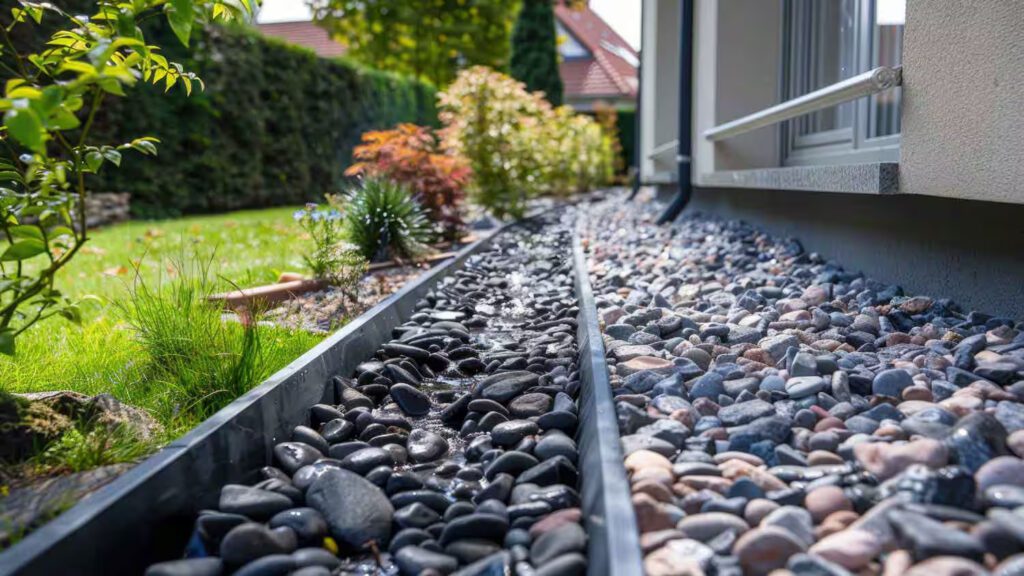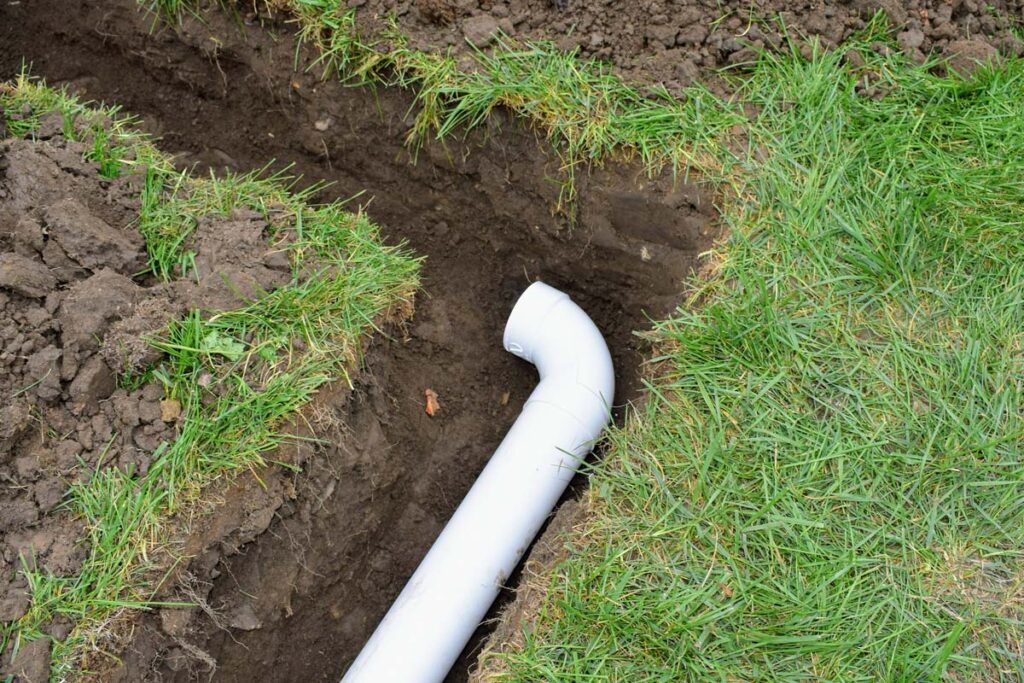How Much Water Can a French Drain Handle? – Storm Solutions
A French drain is crucial for managing stormwater runoff, especially in flood-prone areas. But how much water can it handle before becoming overwhelmed?
Understanding its capacity is key to ensuring proper function.
This guide will explain the factors affecting a French drain’s water-handling ability and provide maintenance tips for optimal performance. For homeowners in need of professional help, French drain cleaning in Miramar can ensure your system stays clear of clogs and operates efficiently year-round.
How much water can a French drain handle?
A French drain can handle varying amounts of water, typically draining up to 50 gallons per minute depending on its size, slope, and surrounding soil conditions.
Key Takeaways
- French drains are designed to redirect water away from problem areas, but their water-handling capacity can vary depending on several factors.
- The size of the trench, pipe, and drainage outlet all influence how much water a French drain can manage.
- Regular maintenance is essential to ensure your French drain continues to handle water efficiently and avoid blockages.
What Factors Influence How Much Water a French Drain Can Handle?

French drains are not a one-size-fits-all solution. Several factors determine how much water a
French drain can handle at any given time. By understanding these factors, you can ensure that your French drain is suitable for the specific drainage issues you’re facing.
1. Pipe Size and Diameter
The size of the perforated pipe used in a French drain is a major factor in its water-handling capacity.
Larger pipes allow for more water to flow through them, making them ideal for areas that experience heavy rainfall or have more substantial drainage needs. When deciding between perforated vs solid pipe for French drain systems, it’s important to consider the specific drainage goals—perforated pipes are best for collecting and redirecting water from saturated soil, while solid pipes are ideal for transporting water away without allowing any to enter or escape along the way.
Standard French drain pipes typically come in sizes ranging from 4 inches to 6 inches in diameter, but in areas with high water volume, pipes may need to be larger to handle the increased flow.
2. Trench Depth and Width
The dimensions of the trench also influence how much water the French drain can carry.
A wider and deeper trench allows for more gravel and a larger pipe, which increases the system’s water capacity. French drain installation depth is an important factor to consider during the installation process, as it ensures efficient water flow and drainage. Typically, the trench should be at least 18 to 24 inches deep to allow for proper water collection and drainage, depending on the specific needs of the property.
While typical trenches are around 18 to 24 inches deep and 6 to 12 inches wide, deeper trenches may be required in areas with significant water runoff or where the soil absorbs water quickly.
3. Gravel or Rock Size
Gravel or rock placed around the perforated pipe is another important factor.
The gaps between the gravel allow water to flow through easily, and the size of the gravel can affect the rate of water infiltration.
Larger rocks provide more space for water to move through, while finer gravel may become compacted over time and reduce the system’s efficiency.
Using the right size gravel or rock ensures that the water flows freely through the pipe and reduces the risk of clogging. Similarly, calculating the right grease trap size is essential to ensure effective wastewater management in commercial kitchens. An appropriately sized grease trap prevents overflow, reduces maintenance issues, and complies with local regulations.
4. Soil Type and Drainage Conditions
The type of soil in the area where the French drain is installed also plays a role in its water-handling capacity.
Sandy soil allows water to flow through it easily, while clay-heavy soil retains water, slowing down the drainage process.
In areas with poor soil drainage, the French drain may need to be larger or include additional measures, such as a catch basin or sump pump, to manage the water effectively.
5. Outlet Location and Elevation
The outlet where the French drain discharges the water is also crucial to its overall water-handling capacity.
The water must flow to a location where it can be safely absorbed or redirected, such as a stormwater system, dry well, or a lower area of the property.
The elevation of the outlet in relation to the trench is important, as gravity plays a significant role in ensuring water moves through the system.
If the outlet is too high or too low, it may cause backup or slow drainage.
When Is a French Drain Not Enough?
While French drains are effective in many situations, there are times when they may not be enough to manage the water volume.
Here are a few cases where a French drain may not be the best option:
1. Extremely High Water Volume
If your property is in an area that experiences extreme rainfall or has a natural water flow that exceeds the capacity of a French drain, a French drain alone may not be sufficient.
In such cases, you may need to install additional systems, such as a sump pump or retention pond, to manage excess water.
2. Poor Drainage Conditions
In regions with clay soil or areas that are extremely flat, water may not flow through the French drain system efficiently, even if it’s properly installed.
In these situations, it’s essential to assess the layout and condition of the soil before installing a French drain to ensure that water will drain effectively.
3. Inadequate Maintenance
Even the best French drains can become ineffective if not properly maintained. Over time, sediment and debris can build up inside the pipes, reducing the system’s capacity.
Regular cleaning and maintenance are essential to ensure the French drain continues to handle water effectively.
How to Maintain a French Drain for Optimal Performance

To ensure your French drain works at full capacity, regular maintenance is key. Here are a few tips to keep your system in top shape:
1. Regularly Clean the Grate and Outlet
If your French drain is covered with a grate, make sure it is clear of leaves, debris, and dirt. Keeping the outlet area clean ensures that water can flow freely into the drainage system.
2. Check for Blockages
Periodically inspect the pipe for blockages caused by roots, sediment, or debris. If necessary, use a drain snake or high-pressure water to clear any blockages from the pipe.
3. Ensure Proper Flow
Check that the trench has the correct slope, allowing water to flow freely through the system. If the slope is too steep or too shallow, it can affect water movement and cause drainage problems.
4. Inspect for Damage
After heavy rains, inspect your French drain for any signs of damage, such as cracks in the pipe, sinkholes, or water pooling in areas where the drain isn’t working properly. If you notice any issues, have them repaired promptly.
Frequently Asked Questions
1. How much water can a typical French drain handle?
A standard French drain can handle anywhere from 10-20 gallons per minute (GPM) for small residential applications, up to several hundred GPM for high-volume drainage systems.
2. Can a French drain be used in flood-prone areas?
Yes, French drains can be designed for high-volume water flow, but in extremely flood-prone areas, additional systems like sump pumps or retention ponds may be necessary.
3. How often should I maintain my French drain?
French drains should be inspected and cleaned regularly, at least once or twice a year, and after heavy rainfall. This will help prevent blockages and ensure optimal performance.
Conclusion
A French drain is an excellent solution for managing excess water and preventing flooding around your property.
By understanding how much water a French drain can handle and ensuring it is properly sized and maintained, you can ensure that it provides reliable drainage when you need it most. For homeowners and contractors alike, a visual guide to French drains can be incredibly helpful in illustrating proper installation techniques, ideal materials, and common troubleshooting tips, making it easier to create an effective and lasting drainage solution.
If you’re in an area with higher water runoff or need additional assistance, consider consulting a professional to design a system that meets your specific needs. It’s also wise to factor in the cost of a French drain, as prices can vary based on materials, labor, and the complexity of the installation.
With the right setup and upkeep, your French drain can effectively manage water and protect your home from water damage for years to come.
